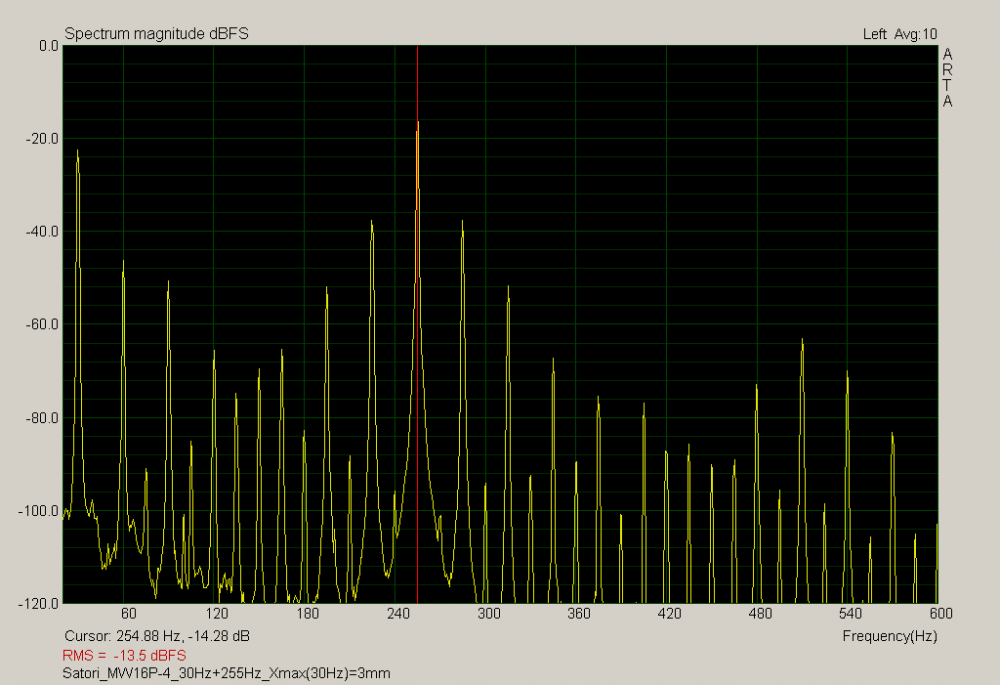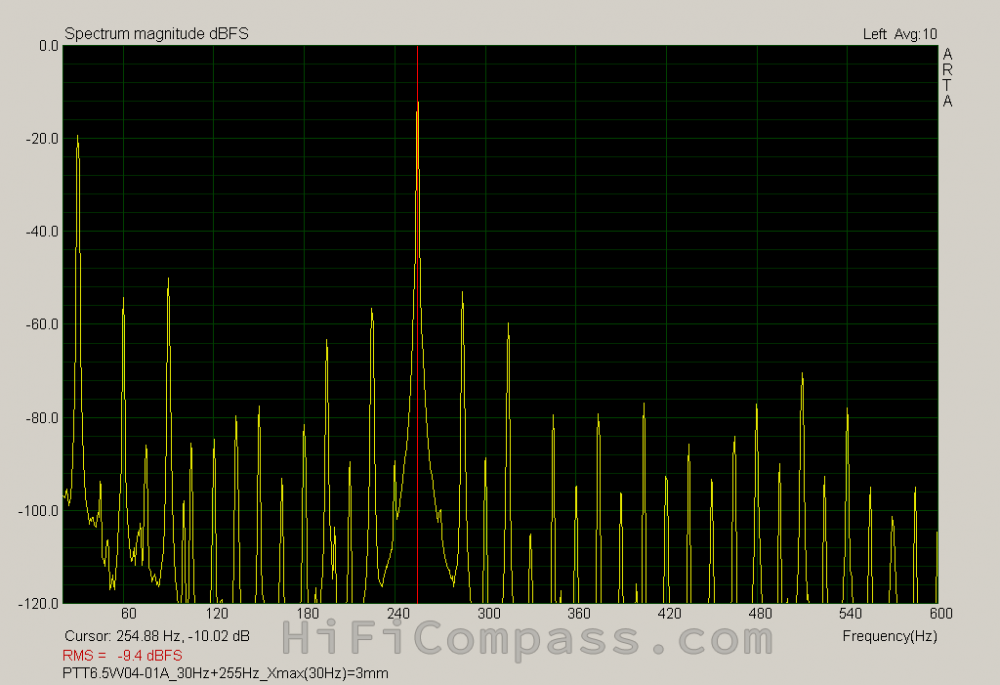Bliesma T25B-6 vs Accuton C25-6-158
Both have already been measured on Hificompass
Accuton C25-6-158 CELL | HiFiCompass
BlieSMa T25B-6 | HiFiCompass
I think Satori MW16 would qualify as widely known and good sound.
Hi All ! is there a cone driver among the ones tested that is widely known for providing a very good sound ? i would like to take a look at its THD performance. Out of curiosity.
Thanks !
I think Satori MW16 would qualify as widely known and good sound.
Hi ! thank you very much indeed.
I guess i found the page
Satori MW16P-4 6" Egyptian Papyrus Cone Woofer | HiFiCompass - всё для акустических систем и не только
but not the THD measurements
Hi ! thank you very much indeed.
I guess i found the page
Satori MW16P-4 6" Egyptian Papyrus Cone Woofer | HiFiCompass - всё для акустических систем и не только
but not the THD measurements
Satori MW16P-4 | HiFiCompass - всё для акустических систем и не только
Also check this one: Purifi PTT6.5W04-01A | HiFiCompass - всё для акустических систем и не только
We had a talk about him publishing subjective experience between Bliesma T25B-6 vs Accuton C25-6-158, so I'm waiting, that's all
Hi! At last I've done a brief comparison BlieSMa T25B-6 to Accuton C25-6-158 tweeters
I found these tweeters are very close in the sense of timbers, sound texture and dynamics. T25B sounds more laidback and has more airness, I think, due a bit more energy in the top octave. C25 sounds a little forward and ask for a bit equalization in the top end (erly FR falling correction). C25 has a little more weght in cymbals. Overall, the both are very good performers and I like them both.
I think, more thoroughly comparing should be done in conjunction with a midwoofer in a real loudspeaker.
Hi ! thank you very much indeed for the very helpful reply
1st

2nd

it looks like that the 2nd driver has lower THD ? i still think that the secret of good sound is low THD
maybe i am wrong
If i send in a two tones signal i would expect to get again a two tones signal at the output ... i know it is very trivial ... still ...
And i cannot accept the idea of evaluation by ear ... it is stronger than me
Last edited:
That is interesting, I was sure that the T25B would be more similar to an Al-Mg tweeter than the Ceramic or diamond which in some aspects are close to one another. Thanks for taking the time to drop a comment. I know how the C25 sounds and even if it lacks a bit of energy in the top octaves, its very pleasant to listen to. Its a very smooth tweeter just as the beryllium one from my understanding.Hi! At last I've done a brief comparison BlieSMa T25B-6 to Accuton C25-6-158 tweeters.
I found these tweeters are very close in the sense of timbers, sound texture and dynamics. T25B sounds more laidback and has more airness, I think, due a bit more energy in the top octave. C25 sounds a little forward and ask for a bit equalization in the top end (erly FR falling correction). C25 has a little more weght in cymbals. Overall, the both are very good performers and I like them both..
I think, more thoroughly comparing should be done in conjunction with a midwoofer in a real loudspeaker.
Hi ! thank you very much indeed for the very helpful reply
1st

2nd

it looks like that the 2nd driver has lower THD ? i still think that the secret of good sound is low THD
maybe i am wrong
If i send in a two tones signal i would expect to get again a two tones signal at the output ... i know it is very trivial ... still ...
And i cannot accept the idea of evaluation by ear ... it is stronger than me
These two graphs do not show THD (Total Harmonic Distorsion). These are IMD (Intermodulation distortion). THD is just the sum of all HD (harmonic distorsion) products of the driver, which are shown on all Hificompass measurements.
HifiCompass only started to do IMD measurements along the review of the Purifi woofer to compare it with other similar drivers.
Anyway, low IMD is indeed very important for sound quality, and the PTT6.5W04 excels at it.
These two graphs do not show THD (Total Harmonic Distorsion). These are IMD (Intermodulation distortion).
THD is just the sum of all HD (harmonic distorsion) products of the driver, which are shown on all Hificompass measurements.
HifiCompass only started to do IMD measurements along the review of the Purifi woofer to compare it with other similar drivers.
Hi ! thanks a lot for the very kind and valuable explanation.
I was misunderstanding the terms ... and trivializing the all issue. But still i like when the output signal looks like the input signal more or less amplified.
All the distortion products are something not present in the original signal, something added by the transducer more than the amplification i guess.
I think that the quality of the transducer set the max performance available from a speaker.
By the way i like very much indeed this kind of test and i do not understand why it is so rarely found in the drivers' datasheet along with other graph.
I like also a lot the response to impulse ... the waterfall graph. A lot indeed.
Anyway, low IMD is indeed very important for sound quality, and the PTT6.5W04 excels at it.
Thanks again. So you are saying that this is an excellent performance in terms of IMD ?

Last edited:
30Hz is quite low for drivers this size. I can only imagine it is creating quite some excursion which will be highly dependent on the T/S parameters of each driver and enclosure size (if not measured on an infinite baffle).it looks like that the 2nd driver has lower THD ? i still think that the secret of good sound is low THD
maybe i am wrong
If i send in a two tones signal i would expect to get again a two tones signal at the output ... i know it is very trivial ... still ...
And i cannot accept the idea of evaluation by ear ... it is stronger than me
To make a fair comparison, you need to adjust the levels of the tones so that the actual SPL is the same (<0.5dB variation) for both drivers.
Also, some drivers have lower excursion capability than others but can be more linear at lower excursion. E.g. driver A might have 1mm xmax and driver B might have 6mm xmax. Driver A might have lower distortion at 90dB SPL and driver B might have lower distortion at 100dB SPL. Therefore there is merit to testing distortion at various levels.
In overhung drivers, IMD is usually worst due to Le(x) effects, where one frequency falls in the inductive part of the impedance curve and the other frequency produces significant excursion, modulating Le and therefore the amplitude of the first frequency -> inter-modulation distortion. The useful frequency range for a 6.5" midwoofer where the impedance is becoming significantly inductive is 500Hz-3kHz. Try running two tone test with 30Hz and 1kHz instead to evaluate. Above 3kHz IMD will become increasingly worse due to increasing inductive portion of the impedance, however you probably don't want to use a midwoofer up that high so it is pointless to test.
For overhung drivers, BL(x) (flux modulation) causes IMD instead. The same test should expose the IMD caused by BL(x).
Last edited:
30Hz is quite low for drivers this size. I can only imagine it is creating quite some excursion which will be highly dependent on the T/S parameters of each driver and enclosure size (if not measured on an infinite baffle).
To make a fair comparison at low frequencies, you need to adjust the level of the 30Hz tone so that the actual SPL is the same for both drivers.
Also, some drivers have lower excursion capability than others but are more linear at lower excursion. E.g. driver A might have 1mm xmax and driver B might have 6mm xmax.
Driver A might have lower distortion at 90dB SPL and driver B might have lower distortion at 100dB SPL
Hi thanks for the very helpful advice. Actually i have noticed that in some tests years ago. I had a small 2 ways bookshelf.
Cutting out the signals below 80Hz with an electronic xover improved the quality of the midrange with a sound more clear.
However it is very important for me to understand the importance of the IMD measurements.
And again i cannot help but notice that they are very rare. Why ?
What on earth is intermodulation distortion?
Guitarist on youtube
Listening to IMD is all the evidence you need which support the statement that IMD is always worse than a fairly high amount of THD.
Guitarist on youtube
Listening to IMD is all the evidence you need which support the statement that IMD is always worse than a fairly high amount of THD.
Last edited:
However it is very important for me to understand the importance of the IMD measurements.
And again i cannot help but notice that they are very rare. Why ?
The general goal of these measurements is to probe the underlying nonlinear characteristic of the loudspeaker. Taking a sweep over the bandwidth of the driver is one way, two tones input into the driver is another method. The underlying behavior can be quite complicated, even considering only the usual 3 large-signal parameters of direct-radiating loudspeakers: BL(x), Le(x, i, f), and Kms(x). It is worth remembering that even the simplest distortion models can generate IMD.
Our motivation for using multiple tones is that these different spectra in the broadband, which is not clear with only one tone. For instance, Kms and BL both produce significant bass distortion, but BL intermodulates the entire range of the driver.
- Home
- Loudspeakers
- Multi-Way
- Some speaker driver measurements...